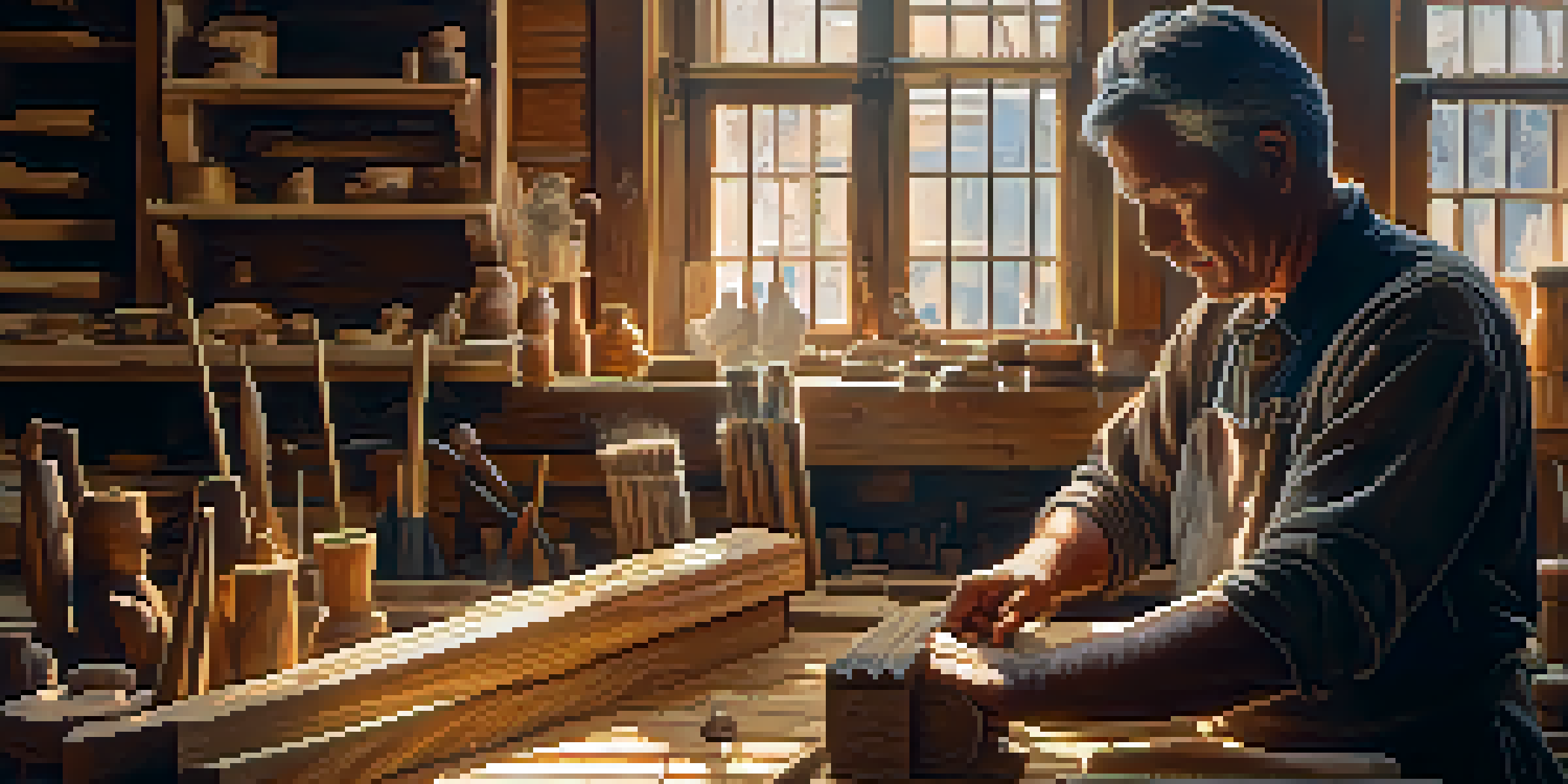The Evolution of Carving Techniques in Restoration Work

Understanding the Importance of Carving in Restoration
Carving plays a crucial role in restoration work, as it allows artisans to recreate original designs and details. This meticulous process not only preserves the aesthetic value of historical pieces but also maintains their integrity. Think of it as a form of historical storytelling; every carved detail has its own narrative that connects us to the past. Without skilled carving, many artifacts would lose their character and historical significance.
Art is not what you see, but what you make others see.
In restoration, carving is not just about aesthetics; it’s also about functionality. Restorers often need to replicate parts that have deteriorated or been damaged over time. For instance, a missing piece of a wooden statue can be replaced by carving a new section that matches the original style, ensuring the piece remains cohesive. This blend of art and craftsmanship is what makes restoration a unique discipline.
Moreover, the techniques used in carving have evolved significantly, reflecting changes in tools, materials, and artistic styles. As restorers adopt new methods and technologies, they also draw inspiration from traditional practices. This evolution not only enhances the quality of restoration work but also contributes to the ongoing dialogue between past and present craftsmanship.
Traditional Carving Techniques: A Historical Perspective
Historically, carving techniques varied greatly depending on the region and cultural influences. For example, the intricate wood carvings of the Gothic period showcased elaborate details that required exceptional skill. Craftsmen of that time relied heavily on hand tools, such as chisels and gouges, which demanded years of dedicated practice to master. These techniques were often passed down through generations, preserving cultural heritage.

In contrast, Renaissance carving introduced a more realistic approach, focusing on human figures and natural forms. Artists began to experiment with perspective and proportion, enhancing the lifelike quality of their work. This shift not only changed the aesthetic of carvings but also influenced the tools used, leading to the development of more specialized instruments. Each era brought its own innovations, shaping the future of carving techniques.
Carving Preserves Historical Integrity
Skilled carving in restoration not only enhances aesthetic value but also maintains the historical significance of artifacts.
Understanding these historical techniques is essential for modern restorers, as it provides context for their work. By studying the methods used by artisans of the past, contemporary craftsmen can better replicate the original techniques in their restorations. This connection to history enriches the restoration process, allowing for a deeper appreciation of the art form.
Advancements in Tools and Materials for Carving
The evolution of carving techniques has been significantly influenced by advancements in tools and materials. In the past, carvers primarily relied on basic hand tools, which limited their ability to execute intricate designs. However, the introduction of power tools revolutionized the field, enabling restorers to achieve greater precision and efficiency. This shift allowed for more complex carvings that would have been challenging with traditional methods.
The best way to predict the future is to create it.
Modern materials have also played a role in enhancing carving techniques. The availability of synthetic materials and advanced woods has expanded the range of options for restorers. For instance, using high-density foam can provide a lightweight alternative for large sculptures, allowing for easier handling without sacrificing detail. These innovations empower restorers to be more creative while ensuring the durability of their work.
Additionally, the use of digital technology, such as 3D modeling and CNC machines, has opened up new possibilities in carving. These tools allow for accurate replication of original designs, making the restoration process faster and more consistent. As technology continues to advance, we can expect even more exciting developments in the field of carving techniques.
The Role of Training and Skill Development in Carving
As carving techniques evolve, so does the need for skilled artisans who can adapt to new methods. Training programs and workshops are essential for developing the next generation of restorers. These educational opportunities not only teach traditional techniques but also introduce students to modern tools and materials. By fostering a strong foundation, aspiring artisans can confidently navigate the complexities of restoration work.
Mentorship also plays a crucial role in skill development. Experienced restorers often take on apprentices, passing down their knowledge and expertise. This hands-on experience is invaluable, as it allows newcomers to learn the nuances of the craft in a supportive environment. The close guidance of a mentor can make a significant difference in an apprentice's growth and understanding of carving techniques.
Advancements Transform Carving Techniques
The evolution of tools and materials, including power tools and digital technology, has revolutionized the precision and efficiency of carving in restoration.
Moreover, the community aspect of carving cannot be overlooked. Joining professional organizations and attending industry conferences enables restorers to network and share best practices. These interactions facilitate the exchange of ideas and innovations, ultimately leading to the evolution of carving techniques across the field.
Cultural Influences on Carving Techniques in Restoration
Cultural influences play a significant role in shaping carving techniques, particularly in restoration work. Different cultures have unique styles and philosophies that inform how restoration is approached. For example, Asian carving often emphasizes harmony with nature, while European styles may focus on ornate details and grandeur. Understanding these cultural nuances is essential for restorers to honor the original intent of the work.
Additionally, globalization has led to a blending of carving techniques across cultures. As artisans share their knowledge and skills, new hybrid techniques emerge, enriching the field of restoration. This cross-pollination allows restorers to draw inspiration from various traditions, creating innovative approaches to their work. The result is a dynamic interplay of styles that reflects our interconnected world.
Recognizing and respecting cultural influences is vital in restoration. When restorers understand the cultural context of a piece, they can make informed decisions that align with its history. This cultural sensitivity ensures that restorations are not only technically sound but also meaningful in their representation of the original work.
Case Studies: Successful Restoration through Innovative Carving
Examining successful restoration projects can provide valuable insights into the evolution of carving techniques. For instance, the restoration of the iconic Notre-Dame Cathedral involved detailed carving to replicate lost architectural elements. Skilled artisans utilized both traditional hand tools and modern technology to ensure the new pieces seamlessly integrated with the original structure. This project exemplifies how a blend of old and new techniques can lead to remarkable results.
Another notable example is the restoration of antique furniture, where artisans often face the challenge of matching original carvings. Using advanced scanning technology, restorers can create accurate templates, allowing them to replicate intricate designs with precision. This approach not only preserves the piece's historical integrity but also enhances its aesthetic appeal, demonstrating the power of innovation in traditional crafts.
Cultural Influences Shape Restoration
Understanding cultural nuances is essential for restorers to honor the original intent and context of the artworks they are restoring.
These case studies highlight the importance of adaptability in carving techniques. As restorers face unique challenges in each project, their ability to innovate while respecting tradition is crucial. The successful outcomes of these restorations serve as inspiration for future artisans, showcasing the potential of carving in enhancing and preserving our cultural heritage.
The Future of Carving Techniques in Restoration Work
Looking ahead, the future of carving techniques in restoration work is poised for continued evolution. As technology advances, we can expect even greater precision and efficiency in the restoration process. For example, the use of augmented reality could allow restorers to visualize how a piece will look after restoration, leading to more informed decisions. This fusion of technology and craftsmanship holds exciting possibilities.
Moreover, sustainability will likely play a more significant role in carving techniques. As awareness of environmental issues grows, restorers may increasingly turn to eco-friendly materials and practices. This shift not only benefits the planet but also encourages innovation in finding alternatives to traditional materials. The future of carving could very well prioritize both artistry and environmental responsibility.

Ultimately, the evolution of carving techniques will continue to be shaped by the interplay of tradition, innovation, and cultural influences. As restorers embrace new tools and methods while honoring historical practices, the craft will remain a vital part of our cultural narrative. The journey of carving in restoration work is far from over; it’s an exciting time to witness how these techniques will adapt and flourish in the years to come.